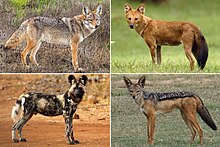犬亚族
犬亚族(英语:Canina)是犬族下的一个分类阶元,也是食蟹狐亚族的近亲。这个群体的化石可以追溯到500万年前,然而它们可能在900万年前就已经存在了[3]:4。该亚族的成员被认为是与狼较为相近的犬科动物[4] [5] [6]。
| 犬亚族 | |
|---|---|

| |
| 科学分类 | |
| 界: | 动物界 Animalia |
| 门: | 脊索动物门 Chordata |
| 纲: | 哺乳纲 Mammalia |
| 目: | 食肉目 Carnivora |
| 科: | 犬科 Canidae |
| 亚科: | 犬亚科 Caninae |
| 族: | 犬族 Canini |
| 亚族: | 犬亚族 Canina 戈特黑尔夫·菲舍尔·冯·瓦尔德海姆, 1817 [2] |
| 属和亚属[3] | |
分类学
编辑基于犬亚族的成员以39对排例的78条染色体核型,它可以与其他犬科动物杂交[4]。
以下分支图基于发表于2005年的Lindblad-Toh et al的系统发育[5],并进行修改,以纳入最近关于犬属动物的发现。[7] [8](p. S1)。
| 犬亚科 |
| ||||||||||||||||||||||||||||||||||||||||||||||||||||||||||||||||||||||||
参考文献
编辑- ^ Wang, Xiaoming; Tedford, Richard H.; Dogs: Their Fossil Relatives and Evolutionary History. New York: Columbia University Press, 2008, page 174
- ^ Fischer de Waldheim, G. Canina. Adversaria Zoological (Memoir Societe Naturelle (Moscow)). 1817, 5: 368–428. p372
- ^ 3.0 3.1 Tedford, Richard H; Wang, Xiaoming(paleontologist); Taylor, Beryl E. Phylogenetic Systematics of the North American Fossil Caninae (Carnivora: Canidae) (PDF). Bulletin of the American Museum of Natural History. 2009, 325: 1–218 [2023-06-15]. S2CID 83594819. doi:10.1206/574.1. hdl:2246/5999. (原始内容存档 (PDF)于2020-05-08).
- ^ 4.0 4.1 Wayne, Robert K. Molecular evolution of the dog family. Trends in Genetics. June 1993, 9 (6): 218–224 [2023-06-15]. PMID 8337763. doi:10.1016/0168-9525(93)90122-x. (原始内容存档于2021-02-24).
- ^ 5.0 5.1 Lindblad-Toh, Kerstin; Wade, Claire M.; Mikkelsen, Tarjei S.; Karlsson, Elinor K.; Jaffe, David B.; Kamal, Michael; et al. Genome sequence, comparative analysis and haplotype structure of the domestic dog. Nature. 2005, 438 (7069): 803–819. Bibcode:2005Natur.438..803L. PMID 16341006. doi:10.1038/nature04338.
- ^ Castelló, J.R. Ch.2 - Wolf-like Canids. Canids of the World: Wolves, Wild Dogs, Foxes, Jackals, Coyotes, and Their Relatives. Princeton University Press. 2018: 74. ISBN 978-0-691-18372-5.
- ^ Perri, Angela R.; Mitchell, Kieren J.; Mouton, Alice; Álvarez-Carretero, Sandra; Hulme-Beaman, Ardern; Haile, James; Jamieson, Alexandra; Meachen, Julie; Lin, Audrey T.; Schubert, Blaine W.; Ameen, Carly; Antipina, Ekaterina E.; Bover, Pere; Brace, Selina; Carmagnini, Alberto; Carøe, Christian; Samaniego Castruita, Jose A.; Chatters, James C.; Dobney, Keith; Dos Reis, Mario; Evin, Allowen; Gaubert, Philippe; Gopalakrishnan, Shyam; Gower, Graham; Heiniger, Holly; Helgen, Kristofer M.; Kapp, Josh; Kosintsev, Pavel A.; Linderholm, Anna; Ozga, Andrew T.; Presslee, Samantha; Salis, Alexander T.; Saremi, Nedda F.; Shew, Colin; Skerry, Katherine; Taranenko, Dmitry E.; Thompson, Mary; Sablin, Mikhail V.; Kuzmin, Yaroslav V.; Collins, Matthew J.; Sinding, Mikkel-Holger S.; Gilbert, M. Thomas P.; Stone, Anne C.; Shapiro, Beth; Van Valkenburgh, Blaire; Wayne, Robert K.; Larson, Greger; Cooper, Alan; Frantz, Laurent A. F. Dire wolves were the last of an ancient New World canid lineage. Nature. 2021, 591 (7848): 87–91 [2023-06-15]. PMID 33442059. S2CID 231604957. doi:10.1038/s41586-020-03082-x. (原始内容存档于2022-12-31).
- ^ Koepfli, Klaus-Peter; Pollinger, John; Godinho, Raquel; Robinson, Jacqueline; Lea, Amanda; Hendricks, Sarah; et al. Genome-wide evidence reveals that African and Eurasian Golden Jackals are distinct species. Current Biology. 2015, 25 (16): 2158–2165. PMID 26234211. doi:10.1016/j.cub.2015.06.060 .